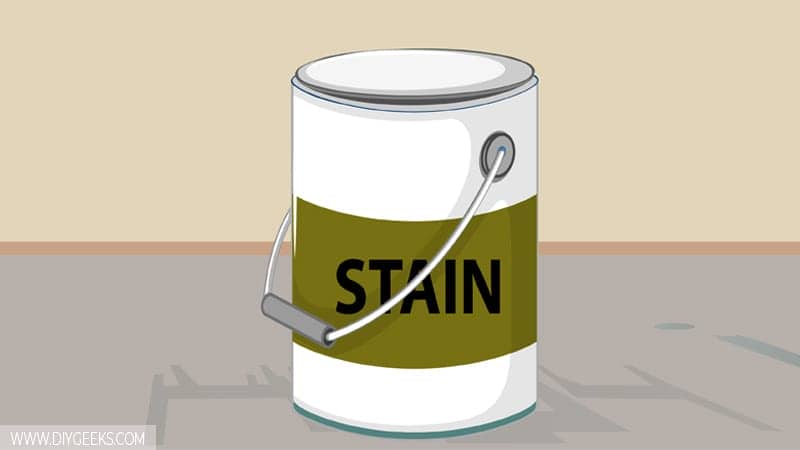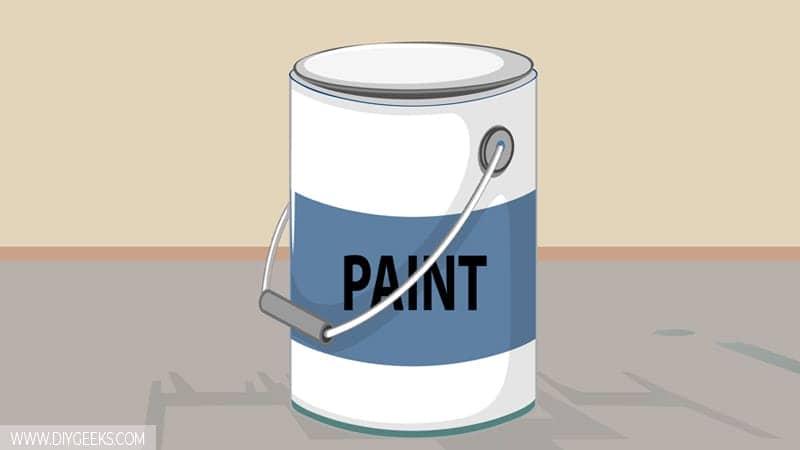Wood stain is a penetrating finish that enhances the wood’s appearance, while paint is a finish that covers the wood’s appearance and creates a durable colorful finish over it.
Wood stain offers better surface adhesion, dries faster, is easier to apply, and costs less than paint. Paint offers better wood protection, durability, and moisture-resistance than wood stain.
What is Wood Stain?

Wood stain is a finish that enhances the wood’s appearance by creating an amber-like semi-transparent over it. It penetrates the wood pores (or grain) deeply and forms a thin layer over it.
Wood stain formula consists of solvents, pigments, a binder, and dye. Its simple formula gives the stain a colorful finish but doesn’t create a protective finish. The high amount of solvent makes it have a light or thin flow that soaks into the wood with ease.
Different wood stain types include penetrating stains, Gel stains, and water-based stains. Each type has different unique features.
You can use wood stain for the following things.
- To enhance the color of the wood.
- To reveal the wood grain and texture.
- You can use it to tint other wood finishes.
- Use it with wood oils to create a glazed finish.
- Over decorative items and ornaments.
Related Read: Can You Stain Over Paint?
What is Paint?

Paint is a liquid or semi-liquid finish that forms a solid and protective coating to enhance and protect a surface. There are different paint types including water-based, oil-based, and mineral-based paints.
There isn’t a specific formula because different types of paint have different formulas. For instance, high-gloss paint has a lot of sheen on its formula, while flat paint has a low amount of sheen.
Paints change the wood color and protect it to a degree. However, they don’t have many protective additives, so paint won’t last longer than 3-6 months on outdoor surfaces.
You can use paint for the following things.
- To protect the wood (low protection).
- To change the color of the wood.
- It can hide imperfections and spots on the surface.
- You can use it over stains or basecoat (primer).
Related Read: Can You Paint Over Stain?
Wood Stain vs Paint
The differences between wood stain and paint are listed below.
Surface Adhesion
Wood stain has better surface adhesion than paints as it penetrates the wood pores (or grain) deeply. Paint doesn’t penetrate wood pores as deeply and has a weaker surface adhesion.
Wood Protection
Paint protects wood better than wood stain as most paint types are formulated with protective additives that create a durable finish. Wood stain doesn’t protect wood surfaces as it’s not formulated with protective additives.
Dry Time
Wood stain dries faster than paint as it has fewer additives and solvents that must evaporate from the coating. However, the dry time is determined by the wood stain or paint type, temperature levels, and room humidity.
Water-based wood stain takes less than 1 hour to dry between coats, while latex paint takes around 3 hours to dry enough for a re-coat.
Paint Application
Wood stain is easier to apply than paint as you can use all paint tools, including a rag, and it dries fast between coats.
Paint is harder to apply as you must apply a basecoat (primer) first, prep the surface more before applying it, and it takes longer to dry.
Durability
Paint finishes are more durable than wood stain finishes as they are formulated with more protective additives. Wood stain finish isn’t durable and can get removed if exposed to constant water as its finish is water-soluble.
Moisture Resistance
Oil-based paint finishes have better moisture resistance than wood stain finishes as they have a glossy finish that repels low water amounts. Wood stain finish isn’t moisture resistant as its finish is water-soluble.
Cost
Wood stain costs less than oil-based paint as it has a simpler formula that only enhances the wood appearance, but doesn’t protect it.
Primer
Most paints require a primer coating before application, while wood stain doesn’t. The primer coating covers the surface imperfection and enhances paint adhesion.
Wood stain doesn’t need a primer coating, as the stain is designed to penetrate the wood pores and reveal the surface texture.
The Finish
Paint creates different finishes depending on the type and sheen. It creates flat, eggshell, satin, semi-gloss, or high-gloss finishes.
Wood stain creates an amber-like semi-transparent finish that deepens the wood surface color and reveals its texture and grain.
Do You Need Wood Stain or Paint?
Before choosing a wood finish, consider the following things.
- Budget: Use wood stain if you have a lower budget as it costs less.
- Durability: Use paint if you want a more durable and stronger finish as it’s formulated with extra protective additives.
- Moisture Resistance: Use oil-based paint if you want a moisture-resistant finish.
- Finish Type: Use Wood stain if you want an amber-like semi-transparent finish, and use paint if you want a colorful finish.


